Maxent Modeling for Predicting the Potential Geographical Distribution of Castanopsis carlesii under Various Climate Change Scenarios in China
Abstract
1. Introduction
2. Materials and Methods
2.1. Occurrence Sources
2.2. Environmental Data
2.3. Construction and Evaluation of Model
2.4. Division of Suitable Areas
3. Results
3.1. Prediction Accuracy Evaluation of the Model
3.2. Major Environmental Factors
3.3. Potential Geographic Distribution of C. carlesii in China under Current and Future Climate
3.4. Potential Distribution Area and Dynamic Change of C. carlesii under Future Climate Conditions
4. Discussions
5. Conclusions
Author Contributions
Funding
Acknowledgments
Conflicts of Interest
References
- Chen, P.Y.; Welsh, C.; Hamann, A. Geographic variation in growth response of Douglas-fir to inter annual climate variability and projected climate change. Glob. Chang. Biol. 2010, 16, 3374–3385. [Google Scholar] [CrossRef]
- Hu, X.G.; Jin, Y.Q.; Wang, X.R.; Mao, J.F. Predicting impacts of future climate change on the distribution of the widespread conifer Platycladus orientalis. PLoS ONE 2015, 10, e0132326. [Google Scholar] [CrossRef] [PubMed]
- Lucht, W.; Schaphoff, S.; Erbrecht, T.; Heyder, U.; Cramer, W. Terrestrial vegetation redistribution and carbon balance under climate change. Carbon Balance Manag. 2006, 1, 6. [Google Scholar] [CrossRef]
- Zhang, G.; Zeng, G.; Yang, X.; Jiang, Z.H. Future changes in extreme high temperature over China at 1.5–5 °C global warming based on CMIP6 simulations. Adv. Atmos. Sci. 2021, 38, 253–267. [Google Scholar] [CrossRef]
- Gao, X.J.; Zhao, Z.C.; Giorgi, F. Changes of extreme events in regional climate simulations over East Asia. Adv. Atmos. Sci. 2002, 19, 927–942. [Google Scholar]
- Bellard, C.; Bertelsmeier, C.; Leadley, P.; Thuiller, W.; Courchamp, F. Impacts of climate change on the future of biodiversity. Ecol. Lett. 2012, 15, 365–377. [Google Scholar] [CrossRef] [PubMed]
- Levin, D.A. Plant speciation in the age of climate change. Ann. Bot. 2019, 5, 769–775. [Google Scholar] [CrossRef] [PubMed]
- Bertrand, R.; Lenoir, J.; Piedallu, C.; Gabriela, R.D. Changes in plant community composition lag behind climate warming in lowland forests. Nature 2011, 479, 517–520. [Google Scholar] [CrossRef]
- Sun, R.X.; Ye, X.M.; Wang, Z.L.; Lin, X.F. The complete chloroplast genome of Castanopsis carlesii (Hemsl.) Hay. Mitochondrial DNA Part B 2019, 4, 2591–2592. [Google Scholar] [CrossRef]
- Liu, X.F.; Lin, T.C.; Yang, Z.J.; Vadeboncoeur, M.A.; Lin, C.F. Increased litter in subtropical forests boosts soil respiration in natural forests but not plantations of Castanopsis carlesii. Plant Soil 2017, 418, 141–151. [Google Scholar] [CrossRef]
- Li, X.J.; Liu, X.F.; Xie, J.S.; Zhang, Q.F.; Yang, Z.J. Contribution of above ground litter fall and roots to the soil CO2 efflux of two subtropical Cunninghamia lanceolata and Castanopsis carlesii forests. Agric. For. Meteorol. 2021, 311, 108671. [Google Scholar] [CrossRef]
- Ni, X.Y.; Lin, C.F.; Chen, G.S.; Xie, J.S.; Yang, Z.J. Decline in nutrient inputs from litter fall following forest plantation in subtropical China. For. Ecol. Manag. 2021, 496, 119445. [Google Scholar] [CrossRef]
- Ma, S.H.; Chen, G.P.; Du, E.Z.; Tian, D. Effects of nitrogen addition on microbial residues and their contribution to soil organic carbon in China’s forests from tropical to boreal zone. Environ. Pollut. 2020, 268, 115941. [Google Scholar] [CrossRef] [PubMed]
- Phillips, S.J.; Dudík, M. Modeling of species distributions with maxent: New extensions and a comprehensive evaluation. Ecography 2008, 31, 161–175. [Google Scholar] [CrossRef]
- Elith, J.; Leathwick, J.R. Species distribution models: Ecological explanation and prediction across space and time. Annu. Rev. Ecol. Evol. Syst. 2009, 40, 677–697. [Google Scholar] [CrossRef]
- Wittmann, M.E.; Barnes, M.A.; Jerde, C.L.; Jones, L.A.; Lodge, D.M. Confronting species distribution model predictions with species functional traits. Ecol. Evol. 2016, 6, 873–879. [Google Scholar] [CrossRef]
- Cheuk, M.L.; Fischer, G.A. The impact of climate change on the distribution of Castanopsis (Fagaceae) species in South China and Indo-China region. Glob. Ecol. Conserv. 2021, 26, e01388. [Google Scholar] [CrossRef]
- Chen, Y.; Le, X.; Chen, Y.; Cheng, W.; Du, J.; Zhong, Q.; Cheng, D. ldentification of the potential distilution area of Cunninghamia lanceolata in China under climate change based on the MaxEnt model. Chin. J. Appl. Ecol. 2022, 33, 1207–1214. [Google Scholar]
- Dyderski, M.K.; PAŹ, S.; Frelich, L.E.; Jagodziński, A.M. How much does climate change threaten European forest tree species distributions? Glob. Chang. Biol. 2017, 24, 1150–1163. [Google Scholar] [CrossRef]
- Atwater, D.Z.; Ervine, C.; Barney, J.N. Climatic niche shifts are common in introduced plants. Nat. Ecol. Evol. 2018, 2, 34–43. [Google Scholar] [CrossRef]
- Lei, L.; Guan, L.L.; Zhao, H.X.; Huang, Y.; Mou, Q.Y. Modeling habitat suitability of Houttuynia cordata Thunb (Ceercao) using MaxEnt under climate change in China. Ecol. Inform. 2021, 63, 101324. [Google Scholar]
- Luo, A.; Xu, X.; Liu, Y.; Li, Y.; Su, X.; Li, Y.; Lyu, T.; Dimitrov, D.; Larjavaara, M.; Peng, S.; et al. Spatio-temporal patterns in the woodiness of flowering plants. Glob. Ecol. Biogeogr. 2023, 32, 384–396. [Google Scholar] [CrossRef]
- Hijmans, R.J.; Cameron, S.E.; Parra, J.L.; Jones, P.G.; Jarvis, A. Very high resolution interpolated climate surfaces for global land areas. Int. J. Climatol. 2005, 25, 1965–1978. [Google Scholar] [CrossRef]
- Zhu, X.; Ji, Z.; Wen, X. Historical and projected climate change over three major river basins in China from fifth and sixth coupled model intercomparison project models. Int. J. Climatol. 2021, 41, 6455–6473. [Google Scholar] [CrossRef]
- Böhmelt, T. Employing the shared socioeconomic pathways to predict CO2 emissions. Environ. Sci. Policy 2017, 75, 56–64. [Google Scholar] [CrossRef]
- Sharma, S.; Arunachalam, K.; Bhavsar, D.; Kala, R. Modeling habitat suitability of Perilla frutescens with MaxEnt in Uttarakhand—A conservation approach. J. Appl. Res. Med. Aromat. Plants 2018, 10, 99–105. [Google Scholar] [CrossRef]
- Hill, M.P.; Hoffmann, A.A.; McColl, S.A.; Umina, P.A. Distribution of cryptic blue oat mite species in Australia: Current and future climate conditions. Agric. For. Entomol. 2012, 14, 127–137. [Google Scholar] [CrossRef]
- Wei, B.; Wang, R.L.; Hou, K.; Wang, X.Y.; Wu, W. Predicting the current and future cultivation regions of Carthamus tinctorius L. using MaxEnt model under climate change in China. Glob. Ecol. Conserv. 2018, 16, e00477. [Google Scholar] [CrossRef]
- Yang, Z.; Yang, B.; Alatalo, J.M.; Huang, Z.; Yang, F.; Pu, X.; Wang, R.; Yang, W.; Guo, X. Spatio-temporal variation in potential habitats for rare and endangered plants and habitat conservation based on the maximum entropy model. Sci. Total Environ. 2021, 784, 147080. [Google Scholar] [CrossRef] [PubMed]
- Anderson, R.P.; Gonzalez, I. Species-specific tuning increases robustness to sampling bias in models of species distributions: An implementation with Maxent. Ecol. Model 2011, 222, 2796–2811. [Google Scholar] [CrossRef]
- Liu, Y.; Huang, P.; Lin, F.; Yang, W.; Gaisberger, H.; Christopher, K.; Zheng, Y. MaxEnt modelling for predicting the potential distribution of a near threatened rosewood species (Dalbergia cultrata Graham ex Benth). Ecol. Eng. 2019, 141, 105612. [Google Scholar] [CrossRef]
- Swets, J. Measuring the accuracy of diagnostic systems. Science 1988, 240, 1285–1293. [Google Scholar] [CrossRef] [PubMed]
- Li, K.; Zhang, X.W.; Fang, Y.M. Responses of the distribution pattern of Quercus chenii to climate change following the Last Glacial Maximum. Chin. J. Plant Ecol. 2016, 40, 1164–1178. [Google Scholar]
- Ding, Y.; Shi, Y.; Yang, S. Molecular regulation of plant responses to environmental temperatures. Mol. Ecular. Plant 2020, 13, 544–564. [Google Scholar] [CrossRef]
- Zeppel, M.J.B.; Wilks, J.V.; Lewis, J.D. Impacts of extreme precipitation and seasonal changes in precipitation on plants. Biogeosciences 2014, 11, 3083–3093. [Google Scholar] [CrossRef]
- Miao, J.; Wang, Y.; Wang, L.; Xu, X. Prediction of potential geographical distribution pattern change for Castanopsis sclerophylla on MaxEnt. J. Nanjing For. Univ. (Nat. Sci. Ed.) 2021, 45, 193–198. [Google Scholar]
- Liang, X.; He, P.; Liu, H.; Zhu, S.; Uyehara, I.K.; Hou, H.; Wu, G.; Zhang, H.; You, Z.; Xiao, Y.; et al. Precipitation has dominant influences on the variation of plant hydraulics of the native Castanopsis fargesii (Fagaceae) in subtropical China. Agric. For. Meteorol. 2019, 271, 83–91. [Google Scholar] [CrossRef]
- Mishra, A.K. Plant adaptation to global climate change. Atmosphere 2021, 12, 451. [Google Scholar] [CrossRef]
- Li, X.; Li, G.; Fang, Y.M. Prediction of potential suitable distribution areas of Quercus fabri in China based on an optimized maxent model. Sci. Silvae Sin. 2018, 54, 154–164. [Google Scholar]
- Ye, X.M.; Chen, F.S.; Sun, R.X.; Wu, N.S.; Liu, B.; Song, Y.L. Prediction of potential suitable distribution areas for Choerospondias axillaris based on MaxEnt model. Acta Agric. Univ. Jiangxiensis 2019, 41, 440–446. [Google Scholar]
- Gong, W.; Xia, Q.; Chen, H.F.; Yu, X.H.; Wu, F. Prediction of potential distributions of Bretschneidera sinensis, an rare and endangered plant species in China. J. South China Agric. Univ. 2015, 36, 98–104. [Google Scholar]
- Sun, R.; Lin, F.; Huang, P.; Ye, X.; Lai, J.; Zheng, Y. Phylogeographical structure of Liquidambar formosana Hance revealed by chloroplast phylogeography and species distribution models. Forests 2019, 10, 858. [Google Scholar] [CrossRef]
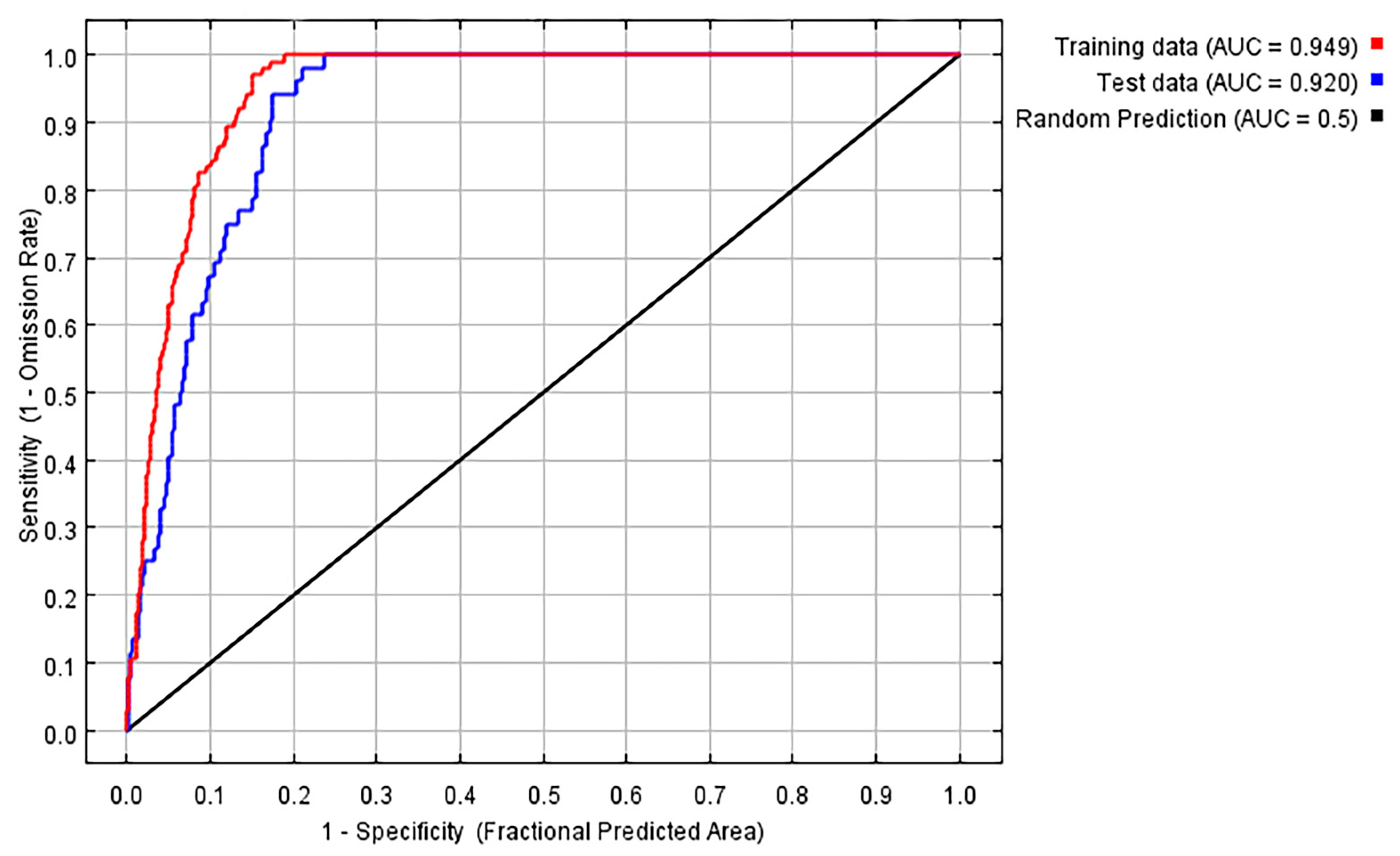
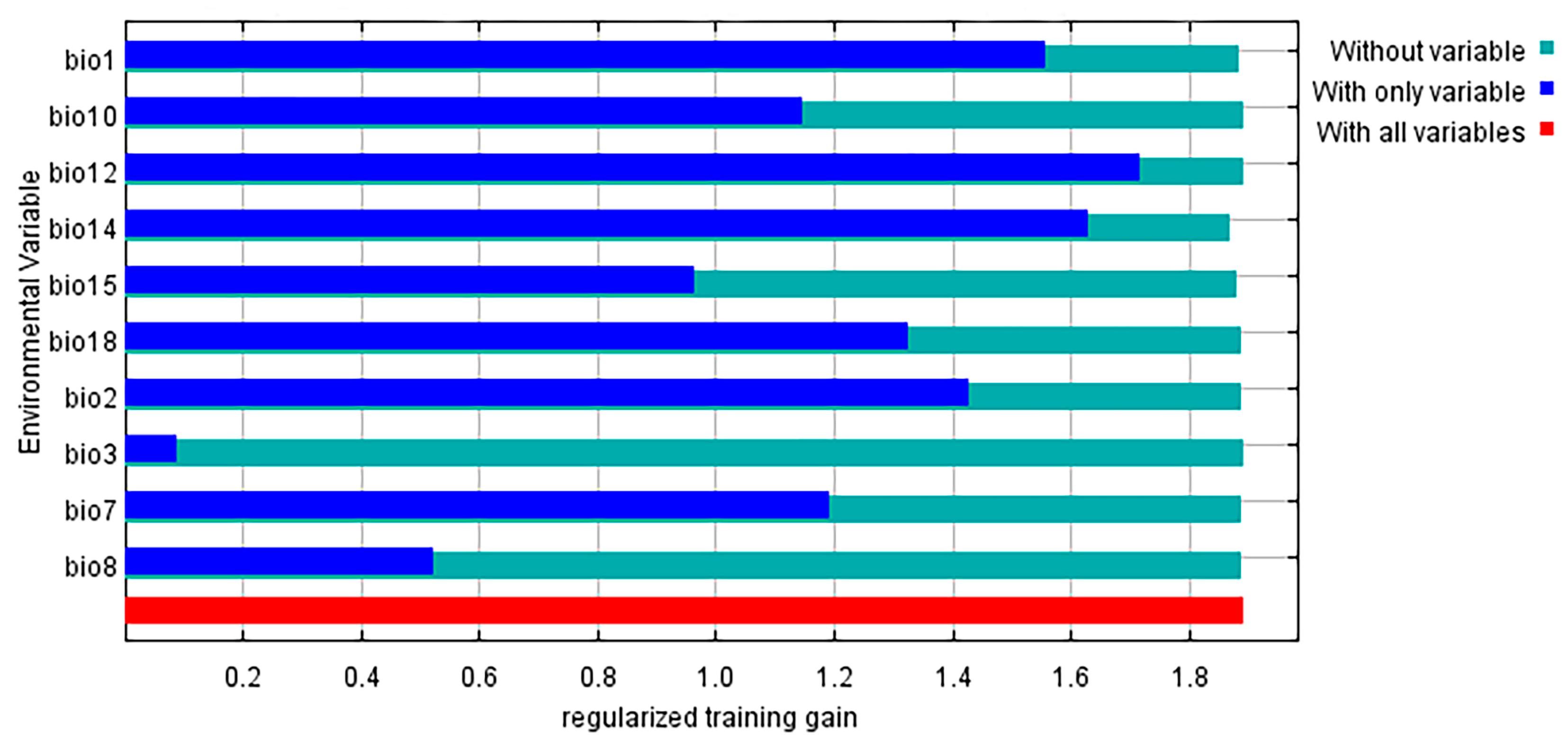
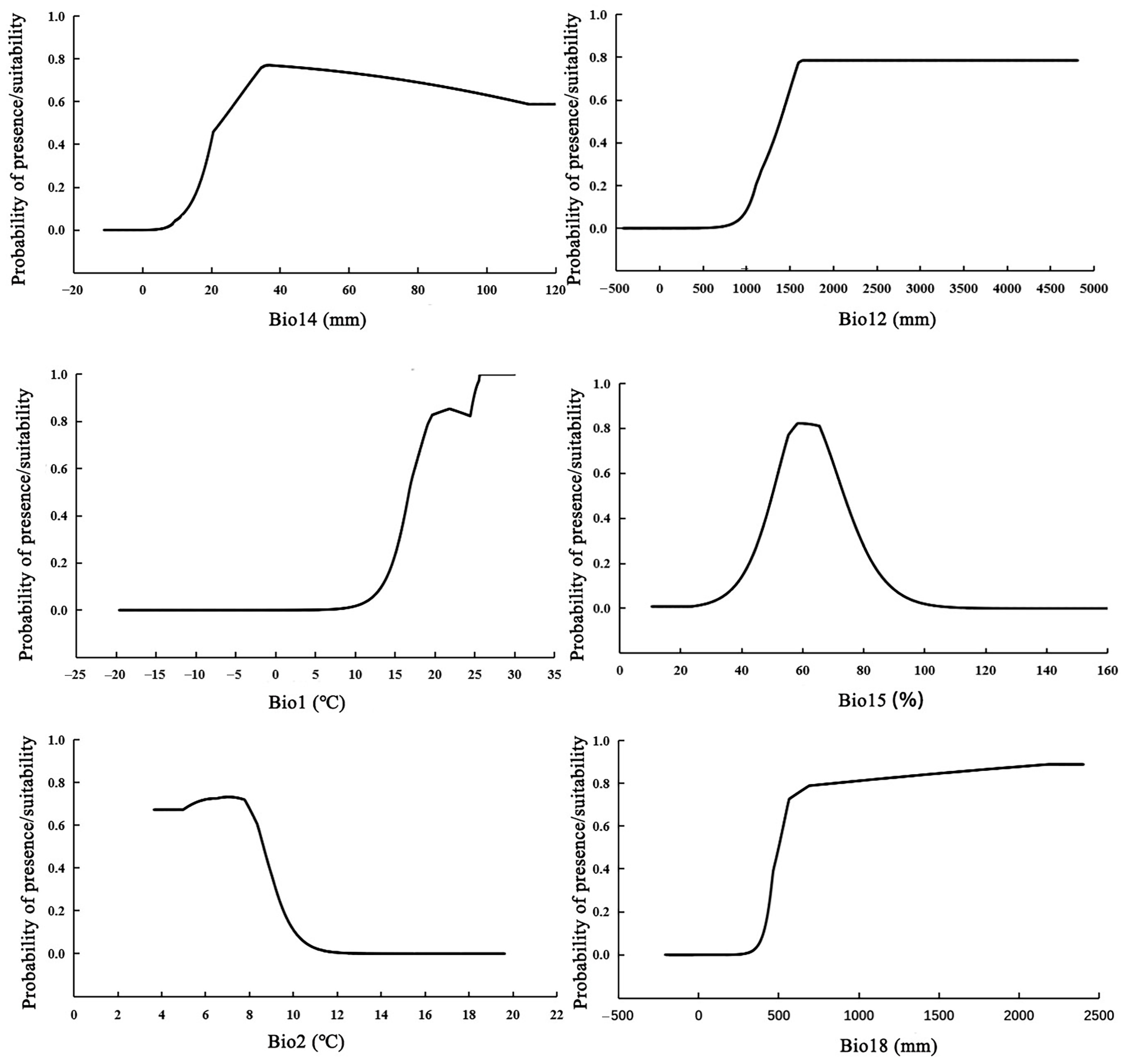
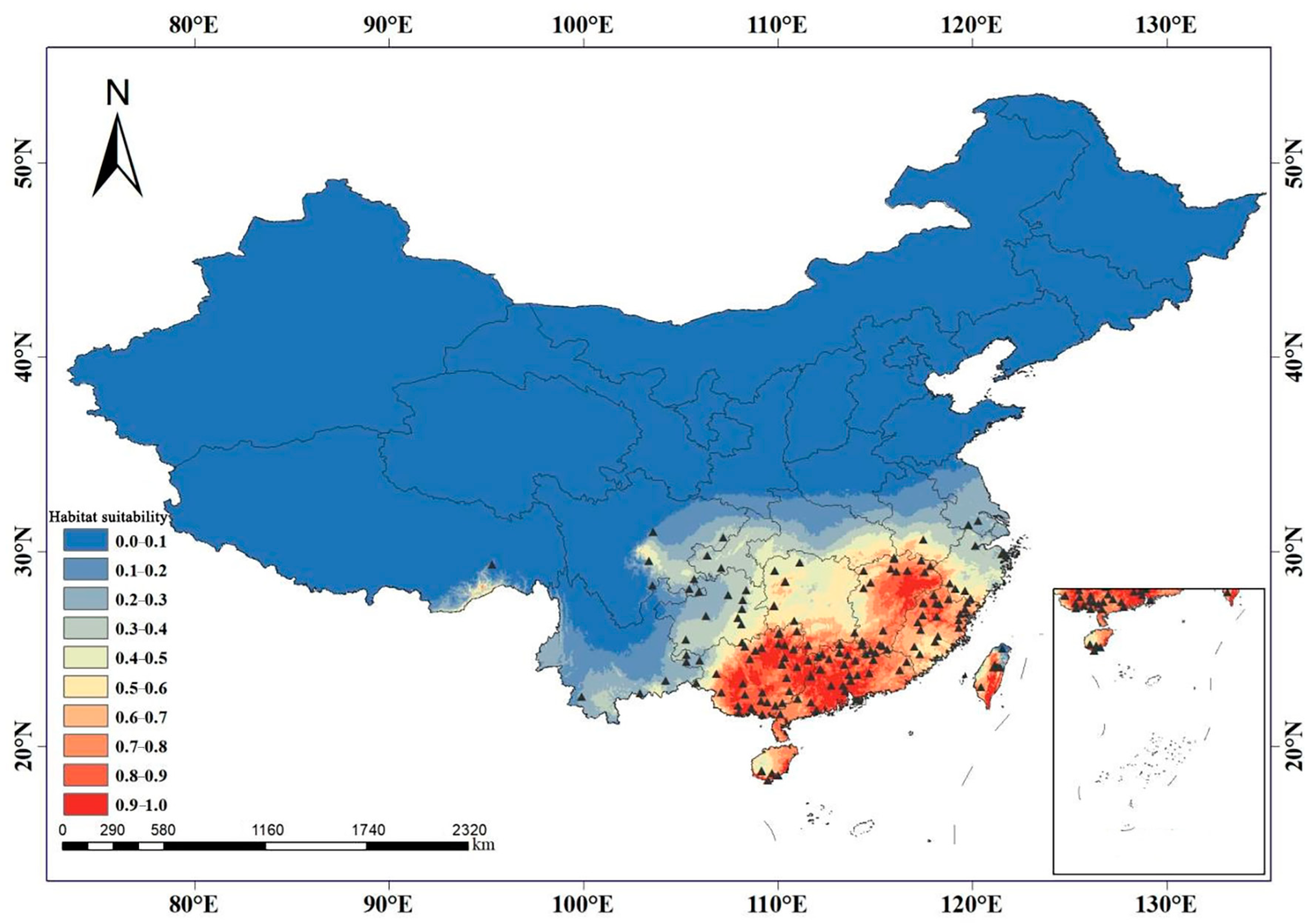

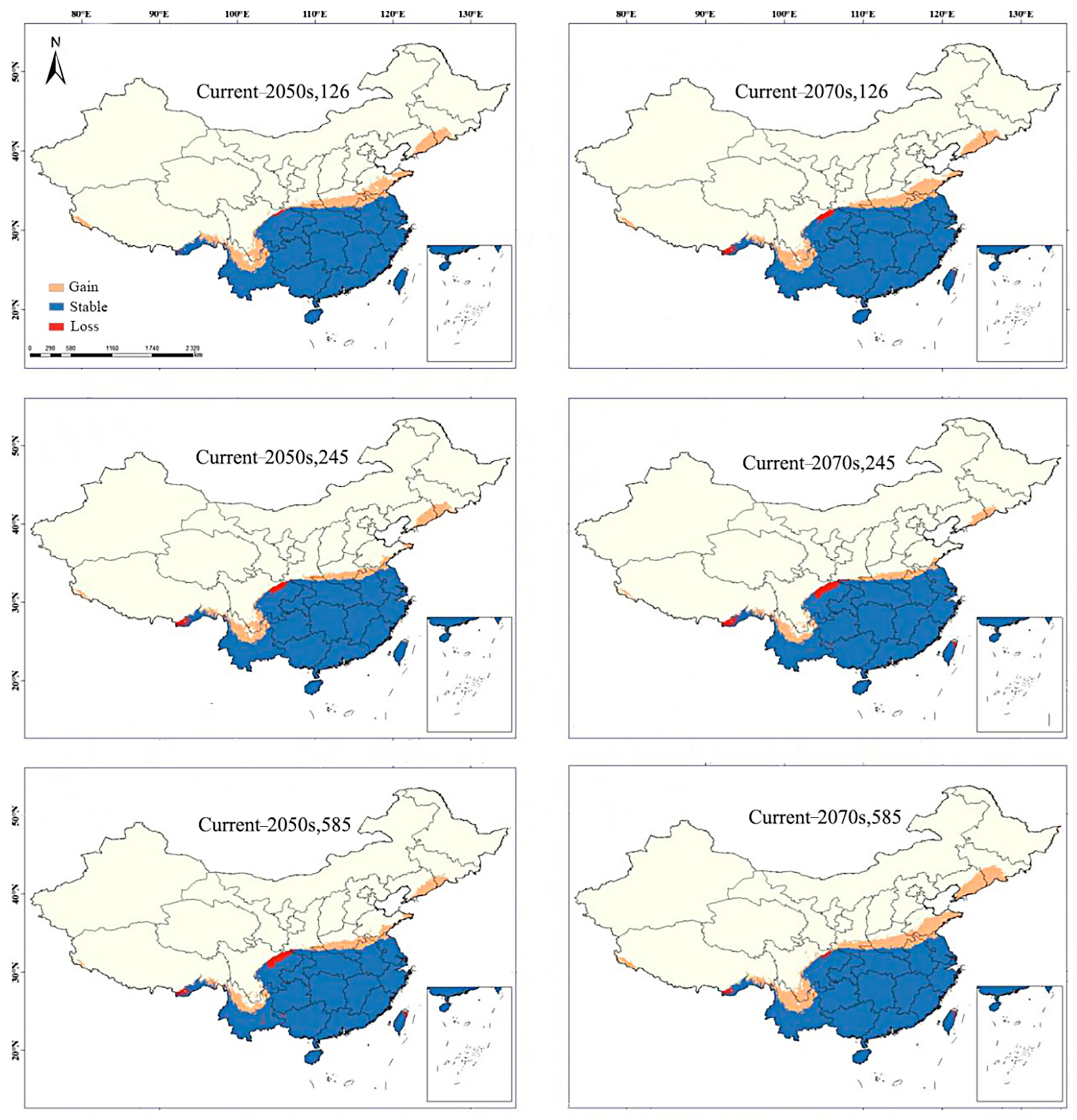
| Index | Description | Percent Contribution/% | Permutation Importance/% |
|---|---|---|---|
| Bio14 | precipitation of driest month | 75.5 | 18.5 |
| Bio12 | annual precipitation | 14.3 | 33.1 |
| Bio1 | annual mean temperature | 5.7 | 15.3 |
| Bio15 | precipitation seasonality | 1.3 | 14 |
| Bio2 | mean diurnal range | 1.2 | 12.7 |
| Bio10 | mean temperature | 0.7 | 1.2 |
| Bio7 | temperature annual range | 0.7 | 1.3 |
| Bio18 | precipitation of warmest quarter | 0.4 | 0.7 |
| Bio8 | mean temperature of wettest quarter | 0.1 | 1.6 |
| Bio3 | isothermality | 0.1 | 1.6 |
| Period | Total Suitable Area | Unsuitable Area | Low-Suitable Area | Moderate-Suitable Area | High-Suitable Area |
|---|---|---|---|---|---|
| Current | 208.66 | 753.11 | 73.64 | 70.28 | 64.74 |
| 2050s (SSP126) | 250.30 | 711.47 | 118.94 | 92.09 | 39.28 |
| 2050s (SSP245) | 235.53 | 726.24 | 114.79 | 99.00 | 21.75 |
| 2050s (SSP585) | 229.66 | 732.12 | 110.35 | 107.28 | 12.03 |
| 2070s (SSP126) | 246.04 | 715.73 | 123.96 | 98.43 | 23.65 |
| 2070s (SSP245) | 224.59 | 737.19 | 110.04 | 103.45 | 11.10 |
| 2070s (SSP585) | 258.69 | 703.08 | 143.44 | 86.17 | 29.08 |
Disclaimer/Publisher’s Note: The statements, opinions and data contained in all publications are solely those of the individual author(s) and contributor(s) and not of MDPI and/or the editor(s). MDPI and/or the editor(s) disclaim responsibility for any injury to people or property resulting from any ideas, methods, instructions or products referred to in the content. |
© 2023 by the authors. Licensee MDPI, Basel, Switzerland. This article is an open access article distributed under the terms and conditions of the Creative Commons Attribution (CC BY) license (https://creativecommons.org/licenses/by/4.0/).
Share and Cite
Zhong, X.; Zhang, L.; Zhang, J.; He, L.; Sun, R. Maxent Modeling for Predicting the Potential Geographical Distribution of Castanopsis carlesii under Various Climate Change Scenarios in China. Forests 2023, 14, 1397. https://doi.org/10.3390/f14071397
Zhong X, Zhang L, Zhang J, He L, Sun R. Maxent Modeling for Predicting the Potential Geographical Distribution of Castanopsis carlesii under Various Climate Change Scenarios in China. Forests. 2023; 14(7):1397. https://doi.org/10.3390/f14071397
Chicago/Turabian StyleZhong, Xiaoru, Lu Zhang, Jiabiao Zhang, Liren He, and Rongxi Sun. 2023. "Maxent Modeling for Predicting the Potential Geographical Distribution of Castanopsis carlesii under Various Climate Change Scenarios in China" Forests 14, no. 7: 1397. https://doi.org/10.3390/f14071397
APA StyleZhong, X., Zhang, L., Zhang, J., He, L., & Sun, R. (2023). Maxent Modeling for Predicting the Potential Geographical Distribution of Castanopsis carlesii under Various Climate Change Scenarios in China. Forests, 14(7), 1397. https://doi.org/10.3390/f14071397





